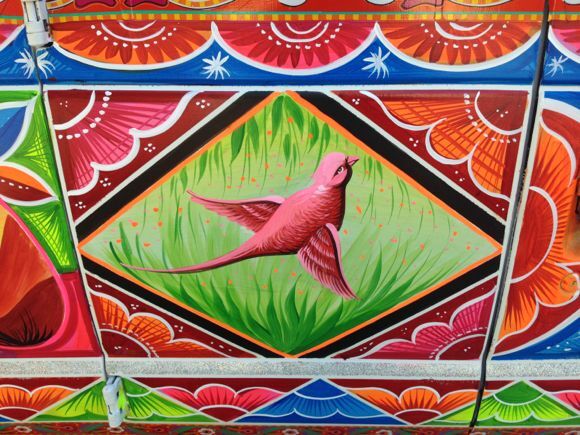Haider Ali: The King of Pakistani Truck Painting

In partnership with The Los Angeles/Islam Arts Initiative, which brings together nearly 30 cultural institutions throughout Los Angeles to tell various stories of traditional and contemporary art from multiple Islamic regions and their significant global diasporas.
The Ford E250 parked near an entrance to USC's campus looks markedly different from the plain white work vans that criss-cross freeways and boulevards throughout Los Angeles. This one is painted in bright shades of orange and pink, green and blue. Various scenes unfold across the sides of the vehicle. On the back are a few jokes written in Urdu. On one side the U.S. stars and stripes greets Pakistan's crescent and star with a bouquet of flowers between the two. Students on skateboards and bicycles whizz past the bus in the late afternoon rush. Every now and again, though, a passer-by stops to ask questions.
Haider Ali is a master at painting very large vehicles. This van is a scaled down demonstration of what he and his team can do. In Ali's native Pakistan, he works on massive trucks and buses. Sometimes, the projects are so grand that they will require over one hundred workers whose specialties range from body work to upholstery. A job like that can take months to complete. This van, though, took about ten days to finish. Ali completed earlier in the day by painting an eagle on the hood. He would have finished earlier, but wanted to save a little for the onlookers at USC.
Late on a Monday afternoon, Ali has his easel set up next to the van. He's painting a gift for USC's Pacific Asia Museum, the organization that facilitated his visit. The flowers that border the canvas match those he has painted on the van. The script on the bottom is a play on words with romantic overtones that is also a joke about the distance between cars on the road. There are similar sayings painted on the van.


The "jingle trucks" of Pakistan have caught many a global eye. "When visitors go to Pakistan, the first thing that strikes them is the sight of these massive trucks or buses," says Hina Abidi, president of the Pakistan Arts Council of USC's Pacific Asia Museum. She adds that, while some say the tradition goes back to the days of ancient caravans, truck art grew popular in the mid-20th century. Companies started investing in elaborate paint jobs to advertise. For others, the messages on their trucks become more personal, with paintings that reflected their hometowns.
The Pakistan Arts Council has been in existence since the early 1990s. The group is comprised of volunteers, some of whom are from Pakistan. Others trace their familial roots to the country. Their goal is to bring the eclectic array of arts from Pakistan to Los Angeles. "Every small town, every village has a unique craft that is very special to that area," says Abidi. Truck art, though, is a nation-wide phenomenon commonly spotted on routes like the Grand Trunk Road.

Ali, who is from Karachi, was seven when his father first taught him the art of truck painting. At 16, he took on his first job, but was unsure of his skills. Ali spent nights practicing the paintings that he would apply to trucks during the day. It wasn't until he painted trucks at the Smithsonian that Ali realized that he was good at his job. Now, twenty-seven years after his education began, Ali teaches the next generation of truck painters. He is also part of Phool Patti, an organization that promotes truck artists from Pakistan across the world.
Throughout the bulk of October, Ali has been an artist-in-residence at the Pacific Asia Museum. He has spent many days painting in the parking lot in front of the Pasadena arts institution. The Saturday before he turned up on USC's campus, there was a reception in his honor, with tablescapes that matched the bold colors and intricately painted scenes depicted on the van. That day, Ali said through an interpreter, that he was creating "a message of peace and love" in his van art. Symbols of the United States, California in particular, meet with symbols of Pakistan.

While Ali's art is quite different from even the more elaborately customized cars in the city, conceptually, his van is at home in Southern California. The Pacific Asia Museum's event was called "From the Grand Trunk Road to Route 66," immediately linking together the culture of travel in two different countries. When truck art became a form of advertising in Pakistan, Southern California business owners embraced Googie architecture, a way to make sure your restaurant or motel was recognizable from the road. Despite the physical distance between Pakistan and Southern California, both places experienced similar art explosions in the mid-20th century.
At the end of his residency, Ali has met L.A. artists who work on cars and streets. He has visited L.A. neighborhoods that overflow with art. And he has won some new fans as well. Out on the edge of the campus at USC, people ask what they can do to help bring his work to more people. They thank him for coming out to the school to paint. In 10 days, Ali created a masterpiece that is as much about Southern California as it is about Pakistan.
All Images Courtesy Los Angeles / Islam Arts Initiative
Dig this story? Sign up for our newsletter to get unique arts & culture stories and videos from across Southern California in your inbox. Also, follow Artbound on Facebook, Twitter, and Youtube.